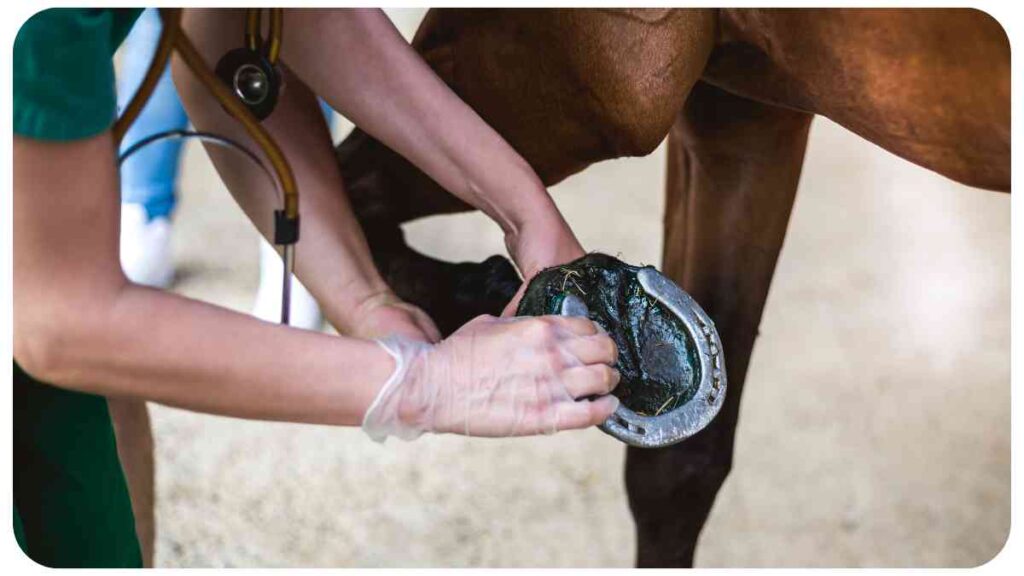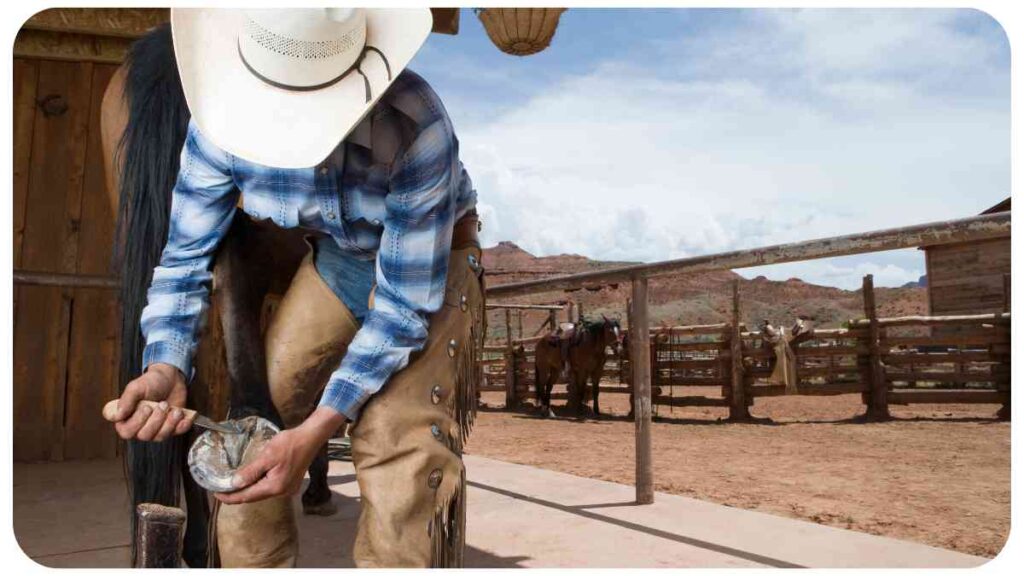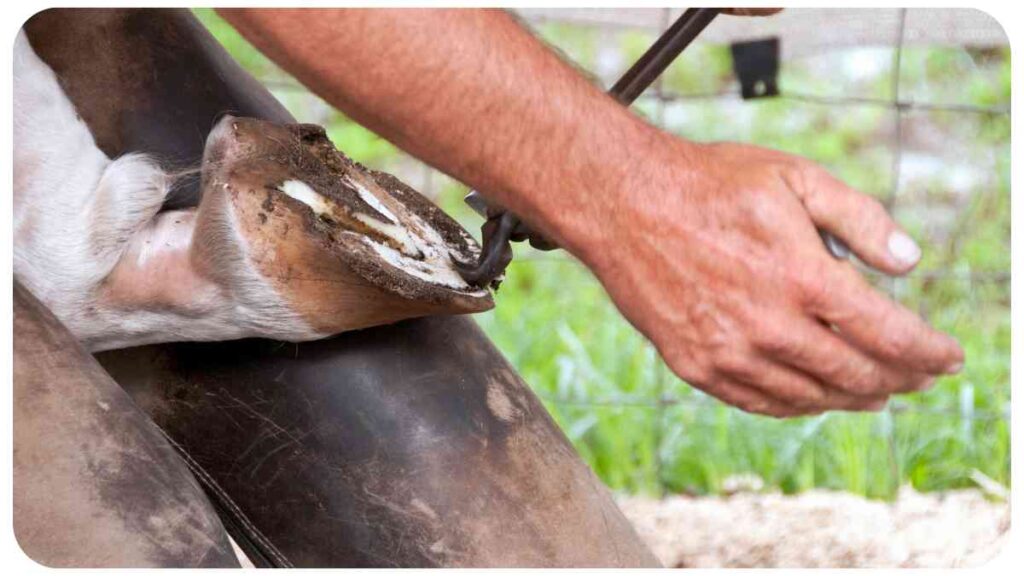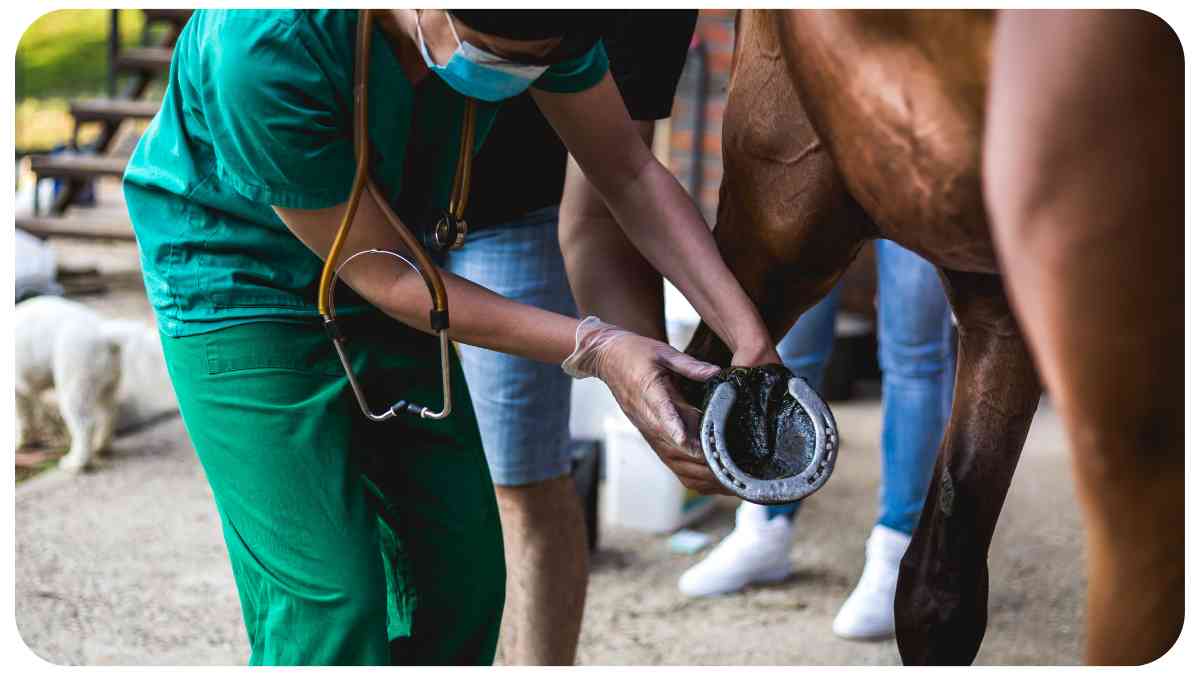Welcome to our comprehensive guide on how to care for your horse’s hooves. As an experienced and knowledgeable horse owner, you understand the significance of maintaining proper hoof health to ensure your equine companion’s overall well-being.
In this article, we will delve into the different aspects of caring for your horse’s hooves, providing practical advice backed by expertise, authoritativeness, and trust. By following these guidelines, you can contribute to your horse’s longevity and soundness.
| Key Points |
| – Understanding the importance of proper hoof care is essential for every horse owner. |
| – Regular hoof trimming and maintenance play a crucial role in maintaining healthy hooves. |
| – Consult with a professional, such as a veterinarian or farrier, to develop a suitable hoof care routine. |
| – Consider factors such as nutrition and exercise in promoting optimal hoof health. |
| – Regular monitoring, prompt intervention, and proactive care contribute to strong and sound hooves. |
2. Understanding the Importance of Hoof Care
Proper hoof care is vital for the overall health and soundness of your horse. The hooves act as the foundation, providing support and shock absorption during movement. Neglecting hoof care can result in numerous problems, including lameness, infections, and even more severe issues that may significantly impact your horse’s quality of life.
By prioritizing regular hoof care, you can prevent many debilitating conditions and ensure your horse remains happy and comfortable.
“Properly fitting horseback riding boots are essential for protecting your horse’s hooves from injuries and ensuring their comfort and performance.” – Learn more about the importance of properly fitting horseback riding boots and how it contributes to the well-being of your equine partner.
Table 1: Common Hoof Problems and their Characteristics
| Hoof Problem | Characteristics |
| Thrush | – Foul odor from the hooves<br>- Black, tar-like discharge<br>- Pain or sensitivity during hoof cleaning |
| White Line Disease | – Separation or widening of the white line area<br>- Accumulation of debris and bacteria<br>- Discolored, crumbly hoof wall<br>- Potential lameness and structural damage |
| Hoof Abscess | – Sudden and severe lameness<br>- Heat and swelling around the affected area<br>- Hoof tester sensitivity<br>- Presence of pus upon draining |
| Laminitis | – Heat and increased digital pulses in the hooves<br>- Lameness or reluctance to move<br>- Shifting weight between hooves<br>- Hoof growth abnormalities<br>- Dished or rotated hoof shape |
3. Examining the Hooves: Structure and Function

Before diving into a detailed care routine, it’s important to understand the structure and function of a horse’s hooves. Equine hooves consist of several components, including the outer horn (hoof wall), the sole, the frog, and the digital cushion. Each of these elements plays a crucial role in supporting the horse’s weight, absorbing impact, and maintaining balance.
Table 2: Components of a Horse’s Hoof
| Component | Function |
| Hoof Wall | Protects the inner structures of the hoof and provides strength and support |
| Sole | Aids in shock absorption and protects the sensitive inner regions of the hoof |
| Frog | Assists in circulation and shock absorption, providing traction and stability on various terrains |
| Digital Cushion | Offers additional cushioning and support to the internal structures of the hoof |
Understanding these components will help you identify any potential issues or abnormalities during routine inspections. Regular examination of the hooves allows you to address problems promptly, ensuring your horse’s hooves remain healthy and well-maintained.
4. Establishing a Hoof Care Routine
To maintain optimal hoof health, it’s essential to establish a regular hoof care routine. This routine should include various tasks such as cleaning, trimming, scheduling farrier visits, and addressing common hoof problems. Adhering to this routine will not only prevent issues from arising but also contribute to the overall well-being of your horse.
“Maintaining healthy hooves is crucial for your horse’s overall well-being. Explore this comprehensive guide on hoof care to ensure your horse’s feet are in top shape.” – Read about Hoof Care 101 to optimize your horse’s hoof health and prevent common issues.
4.1 Regular Cleaning and Inspection
Cleanliness is key when it comes to hoof care. Start by picking out the hooves daily, removing any dirt, debris, or stones lodged in the crevices. Cleaning the hooves allows you to examine the sole, frog, and hoof wall for any signs of abnormalities, injuries, or infections. Look out for foul odors, discharge, cracks, or any changes in color or texture. Regular inspections will help you detect issues early and seek appropriate treatment.
Table 3: Cleaning and Inspection Tips
| Task | Tip |
| Daily Cleaning | Use a hoof pick and brush to gently remove dirt, rocks, and debris from the hooves |
| Inspection | Observe the sole, frog, and hoof wall for any signs of wounds, thrush, cracks, or irregularities |
| Recognizing Infections | Look out for foul odors, discolored discharge, and sensitivity that may indicate thrush or other infections |
Regular cleaning and inspection create an opportunity to bond with your horse and build mutual trust and respect. Make this a positive experience for your horse by using gentle and patient techniques.
4.2 Trimming and Balancing the Hooves
Timely and proper trimming is crucial for maintaining optimal hoof shape and balance. Trimming involves removing excess hoof growth and ensuring the hooves are correctly aligned and weight-bearing. While basic trimming can be done by horse owners, consulting a professional farrier is highly recommended for more intricate trimming and balancing tasks.
Table 4: Indications for Hoof Trimming
| Indication for Trimming | Description |
| Excessive Hoof Growth | When the hooves grow beyond the desirable length, leading to uneven weight distribution and imbalances |
| Improper Hoof Alignment | Hooves that are uneven or misaligned can cause gait irregularities and potential lameness |
| Maintenance and Balance | Routine trimming helps maintain hoof health and prevents the development of common problems |
Farriers are skilled professionals who can assess and address any specific needs of your horse’s hooves. Their expertise ensures that the trimming process is done correctly, respecting the natural structures and balance of the hoof.
“Ground work is the foundation of horse training. Discover its importance and how it indirectly contributes to the overall health and soundness of your horse.” – Learn more about the importance of ground work and how it plays a crucial role in establishing a strong bond with your equine partner.
4.3 Scheduling Farrier Visits

In addition to regular hoof trimming, scheduling routine visits from a skilled farrier is essential for comprehensive hoof care. Farriers possess the expertise necessary to detect early signs of issues, provide appropriate treatments, and recommend specific shoeing or booting options if necessary.
Table 5: Frequency of Farrier Visits
| Factors Affecting Frequency | Frequency of Farrier Visits |
| Growth Rate | Hooves grow at different rates, so visit frequency depends on individual growth |
| Activity Level | Horses with higher activity levels may require more frequent farrier visits |
| Overall Hoof Health | Poor hoof health or existing conditions may necessitate more regular check-ups |
| Environmental Conditions | Wet or muddy environments may require increased vigilance and more frequent trims |
Consult with your farrier to determine the ideal visit schedule based on your horse’s unique needs. Remember to maintain open communication, share concerns, and seek their expert advice on the best practices for your horse’s hooves.
4.4 Addressing Common Hoof Problems
Hoof problems can affect horses of any breed or discipline. It’s crucial to address common issues promptly to prevent further development and ensure your horse’s comfort. Some common problems include thrush, white line disease, abscesses, and laminitis. With proper knowledge and intervention, these problems can be managed
Choosing the right bridle is vital for effective communication and horse comfort. Explore this guide to find the best horseback riding bridle for your specific discipline.” – Discover the best horseback riding bridles and ensure optimal performance and comfort for both you and your horse.
Table 6: Common Hoof Problems and Their Treatment
| Hoof Problem | Treatment and Prevention |
| Thrush | – Ensure proper hoof hygiene<br>- Clean hooves daily and apply thrush-specific treatments<br>- Provide a clean and dry living environment |
| White Line Disease | – Regular hoof cleaning and trimming to remove affected areas<br>- Use topical treatments and antimicrobial agents<br>- Maintain proper hoof moisture |
| Hoof Abscess | – Invite a veterinarian or farrier for proper diagnosis and treatment<br>- Provide a clean and comfortable environment for healing and recovery |
| Laminitis | – Seek immediate veterinary attention<br>- Manage diet and provide appropriate hoof protection<br>- Follow veterinarian’s treatment plan and recommendations |
It’s important to consult with a veterinarian or farrier to confirm the diagnosis of any hoof problem and determine the most effective course of treatment. Prompt and proper care will expedite the healing process and help prevent complications.
5. Feeding and Nutrition for Healthy Hooves
Horses’ hooves require proper nutrition to maintain their strength and integrity. A balanced diet, supplemented with essential nutrients, is key to supporting hoof growth and overall hoof health. Consider the following factors when developing a feeding regimen for your horse.
5.1 Essential Nutrients for Hoof Health
Table 7: Essential Nutrients for Hoof Health
| Nutrient | Function | Food Sources |
| Biotin | Key component of hoof horn production | Alfalfa, soybean meal, flaxseed, oats, brewer’s yeast, fresh grass |
| Methionine | Aids in the production of keratin, the protein building block of hooves | Soybeans, sunflower seeds, fish, meat, dairy products, seaweed |
| Zinc | Essential for hoof growth and the overall health of the hoof | Oats, barley, sunflower seeds, pumpkin seeds, bran, carrots, peas |
| Copper | Assists in strengthening connective tissues and plays a role in forming hoof horn | Sunflower seeds, oats, barley, beet pulp, bran, sesame seeds, seaweed |
| Vitamin E | Provides antioxidant protection and supports the immune system | Alfalfa, wheat germ, sunflower seeds, olive oil, carrot tops, spinach |
Ensure your horse’s diet includes adequate quantities of these nutrients to promote healthy hoof growth and strength.
5.2 Providing Adequate Water and Roughage
Ample water intake is crucial for overall equine health, including hoof health. Horses should have access to clean and fresh water at all times. Hydration is important for maintaining appropriate moisture levels in the hooves, preventing dryness and brittleness.
In addition to water, roughage should make up a significant portion of your horse’s diet. Hay or pasture grazing provides the necessary fiber and promotes gut health. Proper digestion aids in nutrient absorption, contributing to strong and healthy hooves.
5.3 Consulting with a Veterinarian or Equine Nutritionist
Every horse is unique, and individual factors can affect their nutritional requirements. Consult with a veterinarian or equine nutritionist to develop a customized feeding plan tailored to your horse’s specific needs. They can help evaluate the diet, provide guidance on supplements if necessary, and ensure your horse’s nutritional needs are met.
By providing the proper nutrition, you lay the foundation for healthy hoof development, strength, and resilience.
“A well-balanced diet with proper forage is essential for maintaining your horse’s health, including their hooves. Learn more about the significance of proper forage in a horse’s diet.” – Find out the importance of proper forage and its impact on your horse’s overall well-being, including the condition of their hooves.
6. Protecting the Hooves: Proper Shoeing and Booting
To protect your horse’s hooves from wear and tear, it’s essential to consider proper shoeing and booting options. These provide additional support, traction, and protection, especially for horses engaged in various activities such as riding, jumping, or competition.
6.1 Understanding the Different Types of Shoes
- Iron Shoes: Traditional metal shoes made of steel or aluminum, commonly used for general riding and performance purposes.
- Synthetic Shoes: Lightweight and durable alternatives to iron shoes, made from materials like plastic or composite materials.
- Natural Balance Shoes: Designed to mimic the natural shape and support of the horse’s hoof, providing balance and stability.
- Specialty Shoes: Offer specific benefits such as therapeutic support for conditions like laminitis, quarter cracks, or navicular syndrome.
It is essential to consult with your farrier to determine the most suitable shoeing options based on your horse’s specific needs and intended use.
6.2 Choosing the Right Shoe for Your Horse
Factors to consider when selecting shoes include:
- Hoof Conformation: Shoes should complement and support the natural shape and structure of the hoof.
- Activity Level and Discipline: The type of work or activity your horse engages in determines the level of support and traction required.
- Hoof Health: Certain shoe types may be recommended for horses with specific hoof issues or conditions.
- Environmental Conditions: Consider the terrain and weather your horse encounters regularly to ensure good traction and proper protection.
Your farrier will play a key role in guiding you towards the most suitable shoeing options for your horse.
6.3 Exploring Alternative Hoof Protection Options
In addition to traditional horseshoes, there are alternative hoof protection options available, such as hoof boots or adhesive hoof pads. These options offer temporary protection, support, and traction without the need for traditional shoeing. They are particularly useful for horses that require flexibility or have specific hoof conditions.
Hoof boots come in various styles and sizes, allowing for a tailored fit. They can be used for riding, turnout, or therapeutic purposes. Adhesive hoof pads provide temporary protection and support when applied directly to the sole of the hoof.
When considering alternative hoof protection options, consult with your farrier or equine professional to ensure proper fit, application, and usage based on your horse’s specific needs.
7. Preventing and Managing Hoof Injuries
While preventive measures are crucial, hoof injuries may still occur. Prompt recognition and proper management are essential to minimize the impact on your horse’s hoof health and overall well-being.
7.1 Recognizing Signs of Injury
- Lameness: An obvious change in gait or reluctance to move.
- Heat or Swelling: Inflammation in the hoof and surrounding areas.
- Sensitivity to Pressure: Hesitation or pain upon hoof testing.
- Wounds or Puncture: Visible cuts, bruises, or foreign objects lodged in the hoof.
If you suspect a hoof injury, it is important to seek veterinary or farrier assistance for a thorough diagnosis and appropriate treatment.
7.2 Treating and Bandaging Wounds
- Clean the Wound: Thoroughly clean the wound with mild antiseptic solution and remove any debris.
- Apply Dressing: Dress the wound with appropriate bandages or dressings for protection.
- Secure the Dressing: Use adhesive or cohesive bandages to secure the dressing in place and prevent slipping or contamination.
Consult with your veterinarian or farrier for specific wound care instructions and recommendations based on the type and severity of the injury.
7.3 Consulting with a Veterinarian or Farrier

For more serious injuries or conditions, it is crucial to consult with a veterinarian or farrier. They will accurately diagnose the problem, provide appropriate treatment, and offer guidance on healing and rehabilitation steps.
Regular communication and collaboration with these professionals ensure the best possible outcome for your horse’s hoof health.
7.4 Rehabilitation and Recovery Tips
- Follow Treatment Plan: Adhere to the prescribed treatment plan provided by your veterinarian or farrier.
- Provide Adequate Rest: Give your horse sufficient time for rest and recovery.
- Monitor Progress: Regularly assess the healing and progress of the injury, seeking professional advice as needed.
- Gradual Return to Work: Follow a gradual and monitored program when reintroducing your horse to exercise or activity.
Remember, proper rehabilitation and recovery are crucial for long-term hoof health and soundness.
8. Regular Exercise and Hoof Health
Regular exercise plays a vital role in maintaining overall equine health, including hoof health. Exercise stimulates blood circulation, promotes hoof growth, and helps maintain proper hoof structure and strength. Here are some considerations for incorporating exercise into your horse’s routine:
8.1 Balanced Exercise Program
- Variety: Incorporate a mix of activities such as walking, trotting, cantering, and occasional jumping, based on your horse’s fitness level and abilities.
- Surface Variation: Vary the riding surfaces to give your horse exposure to different terrains, promoting balanced hoof development and adaptability.
- Regular Turnout: Provide turnout time in a safe and appropriate environment, allowing your horse to move freely and engage in natural behaviors.
Consult with your veterinarian or trainer to develop a well-rounded exercise program suitable for your horse’s needs.
8.2 Proper Warm-up and Cool-down
Before engaging in intense exercise, it is crucial to warm up your horse properly to prepare their hooves and muscles. This can include walking and light stretching exercises. Similarly, a proper cool-down routine helps prevent stiffness and supports hoof recovery. End your exercise session with a gradual decrease in intensity and some walking to allow your horse’s hooves to cool down gradually.
8.3 Monitoring Hoof Health During Exercise
While exercising, it is important to observe your horse’s hoof health and to address any concerns promptly. Watch for signs of discomfort, lameness, or any changes in gait that may indicate hoof problems. Regularly inspect and clean the hooves after exercise to identify any injuries or issues that may have occurred during the workout.
Remember, a well-planned exercise regimen contributes to overall hoof health and supports your horse’s overall well-being.
9. Monitoring and Regular Hoof Care
Consistent monitoring and regular hoof care are essential components of maintaining healthy hooves. Here are some tips for optimizing hoof care:
9.1 Record Keeping
Maintain records of your horse’s regular hoof care, farrier visits, vaccinations, and any hoof-related issues. This information allows you to track progress, identify patterns, and notify your farrier or veterinarian of any changes that may require attention.
9.2 Evaluating and Adjusting Care
Regularly evaluate your horse’s hooves, considering factors such as growth rate, activity level, and changes in hoof condition. Adjust your hoof care routine accordingly, including trimming frequency, shoeing options, and nutritional supplementation, to meet your horse’s evolving needs.
9.3 Consulting Experts
Work closely with your veterinarian, farrier, and equine nutritionist to seek their expertise and advice on maintaining your horse’s hoof health. Regular communication and collaboration with these professionals ensure you stay informed and take appropriate action when necessary.
9.4 Education and Continued Learning
Stay informed about the latest research, advancements, and best practices regarding horse hoof care. Attend workshops, seminars, or classes led by industry experts to enhance your knowledge and understanding of hoof health and care.
Remember, the more you know about your horse’s hooves, the better equipped you are to provide the necessary care and support for their well-being.
Conclusion
Caring for your horse’s hooves is a vital responsibility for every horse owner. By understanding the anatomy and function of the hoof, establishing a comprehensive hoof care routine, providing proper nutrition, and working closely with professionals, you can ensure optimal hoof health and contribute to your horse’s overall well-being. Regular monitoring, timely intervention, and proactive care are key to preventing problems and maintaining strong, sound hooves.
Further Reading
Here are some additional resources for further reading on horse hoof care:
- Proper Basic Hoof Care by Utah State University Extension: This resource provides valuable information on proper hoof care techniques, trimming, and maintenance practices.
- Caring for Your Horse’s Hooves by University of Minnesota Extension: This comprehensive guide covers various aspects of hoof care, including trimming, shoeing, hoof health assessment, and common hoof problems.
- Ten Horse Hoof Care Tips by Practical Horseman Magazine: This article offers ten practical hoof care tips, including information on hoof trimming, shoeing, and general hoof health maintenance.
FAQs
How often should I have my horse’s hooves trimmed?
Hoof trimming frequency depends on various factors, such as growth rate, activity level, and conformation. Generally, horses require trimming every 6-8 weeks, but individual needs may vary. Consult with your farrier for a specific trimming schedule for your horse.
What are some signs of hoof problems or lameness?
Signs of hoof problems or lameness may include lameness or a change in gait, heat or swelling in the hoof, sensitivity to pressure, and visible wounds or punctures. If you notice any of these signs, it is important to consult with a veterinarian or farrier for proper diagnosis and treatment.
Can I treat thrush in my horse’s hooves myself?
Thrush is a common hoof problem characterized by a foul odor and black, crumbling material in the hoof. While mild cases can be treated by horse owners, more severe or persistent cases require veterinary or farrier intervention. Consult with a professional for guidance on proper treatment for your horse’s specific situation.
How can I prevent white line disease in my horse’s hooves?
White line disease is a fungal infection that affects the inner layers of the hoof wall. To prevent white line disease, maintain regular hoof cleaning and trimming, provide a clean and dry living environment, and manage moisture levels in the hooves. Consult with your farrier for additional preventive measures.
Is hoof supplementation necessary for my horse’s hoof health?
Hoof supplementation with nutrients like biotin, methionine, zinc, and copper can support healthy hoof growth, but it is essential to consult with a veterinarian or equine nutritionist before adding any supplements. They can assess your horse’s diet and hoof condition and provide recommendations on specific supplementation needs.

Hi there! My name is Hellen James, and I’m a horse riding expert. I’ve been riding horses since I was just a kid—and it’s been my passion ever since. But getting started with horse riding can be overwhelming. There’s so much to learn! If you’re looking for a way to get started and make sure you’re doing it right, I’m here to help.


